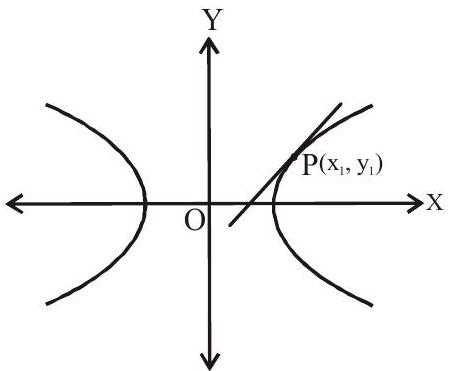HYPERBOLA- 4 (Equation of Tangent)
Equation of Tangent
i. Point Form
Differentiate w.r.t.

Slope of tangent
Equation of tangent,
or
Equation of tangent is
Equation of tangent at point
ii. Parametric Form
Parametric equation of hyperbola is
Equation of tangent is
iii. Slope Form
| Hyperbola: |
Point of contact. |
| Point form : |
|
| Parametric Form : |
|
| Slope form: |
Examples
1. The equation of a tangent to the hyperbola
(a).
(b).
(c).
(d).
Show Answer
Solution:
The equation of the hyperbola is
The equation of tangent of slope
Answer: (a)
2. The point of intersection of two tangents to the hyperbola
(a).
(b).
(c).
(d).
Show Answer
Solution:
Let
If it passes through
Let
Hence locus of
Answer: (c)
3. If the tangents drawn from a point on the hyperbola
(a).
(b).
(c).
(d).
Show Answer
Solution:
Let
The equation of tangent to the ellipse is
If it passes through
Let
Answer: (c)
4. If the line
(a).
(b).
(c).
(d).
Show Answer
Solution:
Equation of hyperbola is
Equation of tangent is
Point of contact is
Answer: (d)
5. Number of real tangents can be drawn from the point
(a). 2
(b). 1
(c). 0
(d). 4
Show Answer
Solution:
Answer: (c)
Practice questions
1.
(a).
(b).
(c).
(d). none of these
Show Answer
Answer: (b)2. Tangents drawn from the point (c,d) to the hyperbola
(a).
(b).
(c).
(d). none of these
Show Answer
Answer: (c)3. The common tangents to the two hyperbolas
(a).
(b).
(c).
(d). none of these
Show Answer
Answer: (a)4. The equation of the tangent to the curve
(a).
(b).
(c).
(d). none of these
Show Answer
Answer: (d)5. The locus of a point
(a). Parabola
(b). circle
(c). ellipse
(d). hyperbola










